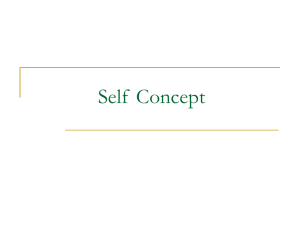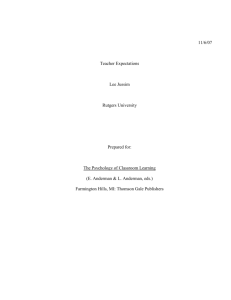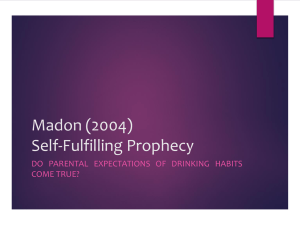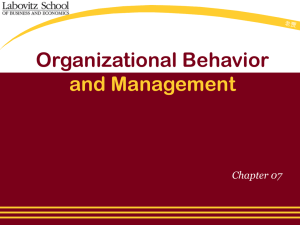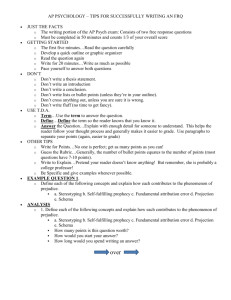Self-fulfilling prophecies. - Program for Disability Research
advertisement
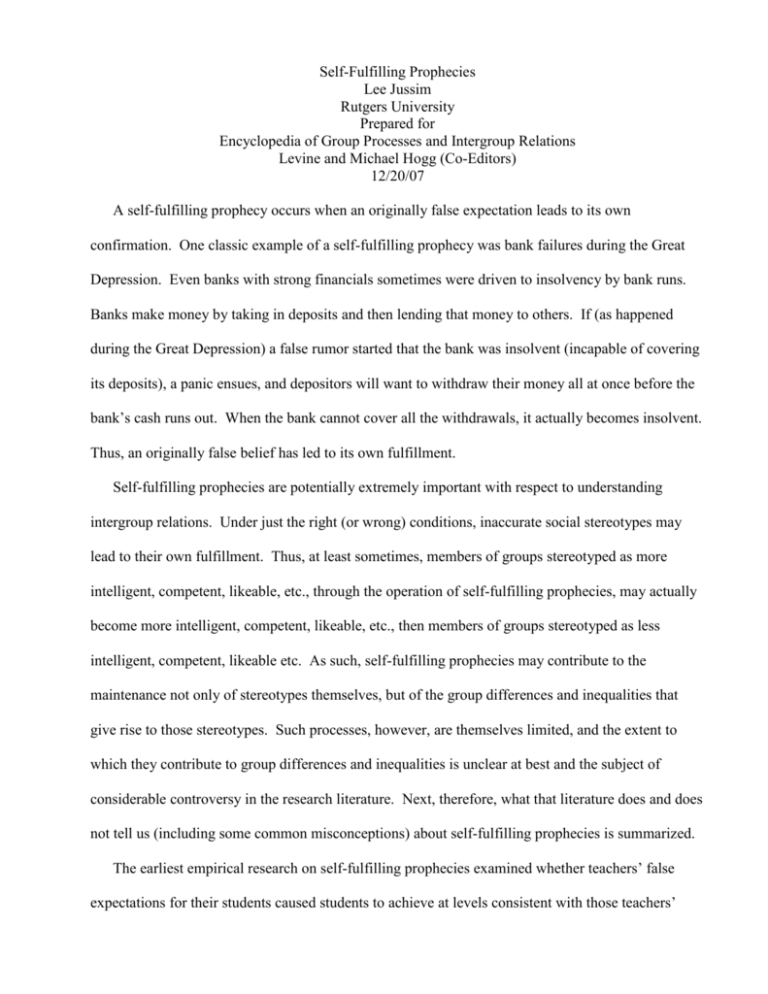
Self-Fulfilling Prophecies Lee Jussim Rutgers University Prepared for Encyclopedia of Group Processes and Intergroup Relations Levine and Michael Hogg (Co-Editors) 12/20/07 A self-fulfilling prophecy occurs when an originally false expectation leads to its own confirmation. One classic example of a self-fulfilling prophecy was bank failures during the Great Depression. Even banks with strong financials sometimes were driven to insolvency by bank runs. Banks make money by taking in deposits and then lending that money to others. If (as happened during the Great Depression) a false rumor started that the bank was insolvent (incapable of covering its deposits), a panic ensues, and depositors will want to withdraw their money all at once before the bank’s cash runs out. When the bank cannot cover all the withdrawals, it actually becomes insolvent. Thus, an originally false belief has led to its own fulfillment. Self-fulfilling prophecies are potentially extremely important with respect to understanding intergroup relations. Under just the right (or wrong) conditions, inaccurate social stereotypes may lead to their own fulfillment. Thus, at least sometimes, members of groups stereotyped as more intelligent, competent, likeable, etc., through the operation of self-fulfilling prophecies, may actually become more intelligent, competent, likeable, etc., then members of groups stereotyped as less intelligent, competent, likeable etc. As such, self-fulfilling prophecies may contribute to the maintenance not only of stereotypes themselves, but of the group differences and inequalities that give rise to those stereotypes. Such processes, however, are themselves limited, and the extent to which they contribute to group differences and inequalities is unclear at best and the subject of considerable controversy in the research literature. Next, therefore, what that literature does and does not tell us (including some common misconceptions) about self-fulfilling prophecies is summarized. The earliest empirical research on self-fulfilling prophecies examined whether teachers’ false expectations for their students caused students to achieve at levels consistent with those teachers’ 2 expectations. Repeatedly, although not always, research demonstrated that teacher expectations are indeed self-fulfilling; students (sometimes) come to perform at levels consistent with their teachers’ originally false expectations. This research has been interpreted by many scholars as providing a powerful and profound insight into a major source of social, educational, and economic inequality. Teacher expectations seemed to systematically advantage students from already advantaged backgrounds (e.g., Whites, middle class students, etc.), and disadvantage students from already disadvantaged backgrounds (e.g., ethnic minorities, students from lower social class backgrounds). To the extent that education is a major stepping-stone towards occupational and economic advancement, self-fulfilling prophecies, it would seem, constituted a major social force operating to keep the oppressed in “their place.” Fuel was further added to the fire of this sort of story by additional early research showing that social stereotypes can indeed be self-fulfilling. Classic studies showed that both physical attractiveness and racial stereotypes could be self-fulfilling. When men interviewed a woman who they falsely believed was physically attractive (accomplished through the use of false photographs a non-face-to-face interviews), the men not only were warmer and friendlier to her, she became warmer and friendlier in response. When White interviewees were treated in the same cold and distant manner by interviewers that White interviewers treated African-Americans interviewees, the performance of the White interviewees suffered. On the basis of these types of finding, some scholars have concluded that self-fulfilling prophecies are a powerful and pervasive source of social injustice and group inequalities. Selffulfilling prophecies have been demonstrated in a wide variety of educational, occupational, professional, and informal contexts. They have been demonstrated in experimental laboratory studies, experimental field studies, and naturalistic studies. Indeed, it is fairly easy to uncritically string together a few of the great early studies and tell a compelling story about how teachers’ expectations, employers’ expectations, and expectations in everyday interactions are likely to 3 victimize people from stigmatized social groups with self-fulfilling prophecy heaped on self-fulfilling prophecy, until, eventually, a great deal of existing social and economic inequalities may appear to be explained by self-fulfilling prophecies. And, indeed, that is exactly what those who emphasize the accumulation of self-fulfilling prophecies have done. The logic here is quite simple. Stereotypes are widely shared and widely inaccurate. Stereotypes lead to inaccurate expectations. Inaccurate expectations are powerfully and pervasively self-fulfilling. Thus, the achievement and advancement of people from socially stigmatized groups will be so repeatedly undermined by self-fulfilling prophecies that self-fulfilling prophecies constitute a major source of social inequalities and social problems. For many reasons, however, the evidence is far more equivocal than is suggested by this very compelling story about the power of self-fulfilling prophecies to create social problems. First, some of the most classic studies have had major methodological problems that seriously cloud the viability of interpreting them as providing clear evidence of self-fulfilling prophecies. Second, many have proven difficult to replicate. Third, overall effect sizes for self-fulfilling prophecies, especially as obtained in naturalistic studies that do not involve experimenters intentionally lying to participants in order to induce false expectations, are not large at all. Fourth, there currently is about as much evidence that positive self-fulfilling prophecies help improve the performance of low achieving students as there is that negative self-fulfilling prophecies harm their performance. Fifth, considerable evidence indicates that people are not rudderless ships, relentlessly tossed around on the seas of other people’s expectations. Instead, people often have their own motivations and goals that enable them to successfully combat others’ false expectations. Overall, therefore, this does not justify a picture of self-fulfilling prophecies as powerful and pervasive sources of social problems. But the picture gets even fuzzier when other research is added to the mix. First, the empirical evidence on stereotypes has not demonstrated widespread inaccuracy. Although not all stereotypes are 100% accurate, most of the empirical studies that have assessed 4 people’s beliefs about groups and then compared those beliefs to criteria regarding what those groups are actually like (Census reports, results from hundreds of empirical studies, self-reports) find that people’s beliefs correspond with groups’ characteristics quite well – indeed, the stereotype accuracy effect sizes are among the largest in all of social psychology. Second, the shared component of stereotypes is typically even more accurate than is the individual or idiosyncratic component. Third, people do not rigidly and powerfully apply their stereotypes when judging individuals. Not only do they readily jettison their stereotypes when clear and relevant personal information is available about the person being judged, overall, the effect of stereotypes on judging individuals is one of the smallest effects in all of social psychology. Thus, some of the key assumptions underlying the “selffulfilling stereotypes are a powerful and pervasive source of social problems” story – that stereotypes are widely shared, widely inaccurate, and powerfully distort expectations for individuals -- seems to be largely invalid. A second important assumption underlying this “story” is that, even if self-fulfilling prophecies are small in any given study, because they likely accumulate over time, those small effects can become quite large and, therefore, can indeed partially account for major social inequalities. For example, let’s say teacher expectations increase the IQ of high expectancy students only 3 points per year, and decrease the IQ of low expectancy students only 3 point per year. If these effects accumulate, then, at the end of 6 years, there would be a 36 IQ point difference between two students who started out with identical IQ test scores! Unfortunately, however, empirical research on self-fulfilling prophecies in education has not provided any evidence of accumulation. Every study that has tested the accumulation hypothesis has not only failed to confirm it; it has found the opposite. Specifically, rather than accumulating to become larger and larger over time, the effects of self-fulfilling prophecies in the classroom dissipate over time. They become smaller and smaller. Why this happens is not currently well-understood. Given the evidence for generally high accuracy in teacher expectations, strongly erroneous teacher 5 expectations may be the exception rather than the rule. Thus, students may be highly unlikely to be the target of the same type of erroneous expectation year after year, thereby limiting the likelihood that they will be subjected to the same erroneous expectation (and its self-fulfilling effects) year after year. Nonetheless, the “story” about the role of self-fulfilling prophecies in social problems should not be completely discarded. Self-fulfilling prophecies probably do play some modest role in social inequalities. First, some of the largest self-fulfilling prophecy effects ever obtained have been found among students from stigmatized social and demographic groups (African-Americans, lower social class students, and students with histories of low achievement). Second, even though educational self-fulfilling prophecies do not accumulate, they can be very long lasting; some evidence shows that 6th grade teacher expectations have self-fulfilling effects as far out as 12th grade. Third, the types of diagnostic labels often used in educational contexts – learning disabled, emotionally disturbed, neurologically impaired – are inaccurately applied sufficiently often that they may frequently create inaccurately low expectations that are indeed self-fulfilling. Because these labels have a veneer of scientific credibility, it may be much harder for students so labeled to shake the inaccurate expectations produced by them. Given the highly mixed nature of the evidence, what conclusions about self-fulfilling prophecies are currently justified? Self-fulfilling prophecies are a real phenomenon and occur in many settings, including laboratories, classrooms, courtrooms, and jobs. In general, self-fulfilling prophecy effect sizes are quite modest. Occasionally, they are quite large. Self-fulfilling prophecies in the classroom dissipate over time. There is insufficient research to reach any conclusion about whether they accumulate or dissipate in other contexts, such as the workplace or family. 6 In general, self-fulfilling prophecies probably play a real yet relatively modest role in creating or maintaining social inequalities based on characteristics such as race, ethnicity, social class, gender, and attractiveness. Nonetheless, there may be some contexts in which this role is quite large.
